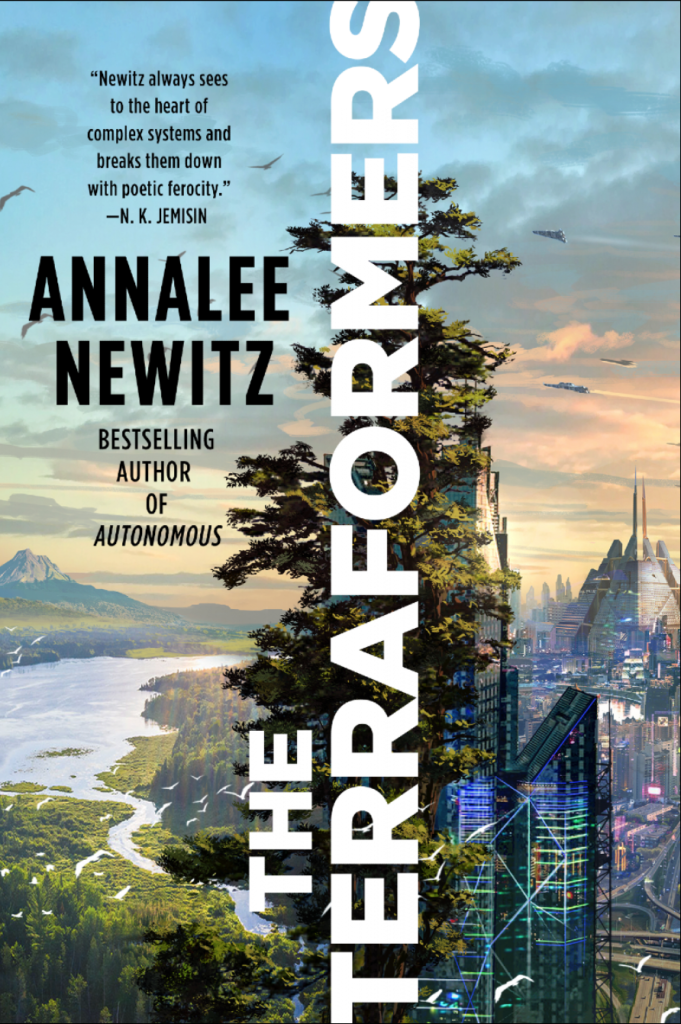Montrealers were in for a rare treat this October: McGill’s Bieler School of Environment invited SF luminaries Annalee Newitz (The Future of Another Timeline) and Kim Stanley Robinson (Mars trilogy) for a ‘solvathon’ on the 12th and 13th at Esplanade Tranquille. And what exactly is a solvathon? The organizers describe it as an event that “bring[s] together writers, researchers, and students across disciplines to tackle key questions at the nexus of storytelling and the climate crisis”. The importance of the event’s remit—to counter the fatalist discourse surrounding environmental matters today with a solutions-oriented, humanistic attitude—cannot be overstated. And, despite the oversaturation of ‘punk’ genres, the event made a good case for any SF aficionado to seek out hopepunk—that is, fiction that emphasizes humanity’s capacity for positive change—as an alternative to the increasingly obsolete cyberpunk, which has not exactly done much to inspire real activism.
The two authors’ keynote speeches explored two sides of the issue, complimenting each other nicely. Newitz’s talk focused on the fiction aspect of the premise, discussing various works dealing with climate change, though not the ones you might expect. Notably, they suggested that N.K. Jemisin’s Broken Earth trilogy challenges the utopia-dystopia binary in presenting a world so transformed by natural and unnatural processes that it can hardly be related to our own negatively or positively. In an interesting twist, the main driver for environmental transformation in this setting is not technology but rather the innate tectonic powers of individuals called ‘Orogenes,’ who are discriminated against by society. Newitz highlighted Jemisin’s focus on the human facets of climate change over the scientific specifics, which soon emerged as a major—and maybe the most valuable—theme of the talk.

Another example of this approach they brought up was Arctic Rising by Tobias S. Buckell, a story about the greedy multinationals seeking to exploit the oil reserves revealed by melting ice caps as well as the pilots of UN airships trying to prevent said exploitation. The new technology and its environmental effects are not the book’s main concern here—it’s the people of this world and what personal, pivotal decisions they make with that tech. Arctic Rising also manages to challenge the utopia-dystopia binary in a different way. Instead of a totally alien scenario like Jemisin’s, this is a future all too similar to our present, where the effects of the climate catastrophe become more and more visible, yet society is trying its best to mitigate them (and failing about as often as it succeeds). Like Newitz’s own Terraformers (and their partner Charlie Jane Anders’ All the Birds in the Sky), this is fiction that picks apart the tremendous nuance around the issue of climate change and fiercely resists oversimplification. The kind of fiction, they argued convincingly, that we need right now.
For his part, Robinson’s lecture turned to more technical issues as he discussed how we might practically mitigate the effects of human activity on the biosphere. Achieving social good with our technology is possible, Robinson argued, pointing to the marvels of transportation and communications infrastructure as examples. The issue is our economic system that values growth at any expense, leading to environmental overexploitation. To combat this, he suggested that we “pay ourselves to do the right thing.” Governments might choose to resolve future economic recessions using “green quantitative easing,” or the purchase of bonds from companies that promote environmental causes. This would effectively be an investment in green projects and might motivate private investors to follow suit.
Robinson stressed the need for world governance as well. International bodies have already made headway in the fight against climate change, like the COP15 resolution to reserve 30% of all land and oceans for nature by 2030, but they need to do more. Robinson also believes that geoengineering technologies will play a role in reversing global warming and cautioned against knee-jerk rejections of them.

At the individual level, he pointed out the link between doing good for the environment and promoting your own well-being. “Paleolithic pleasures” like exercise and being in nature have a low carbon footprint and a positive effect on mental health. Getting involved in local governance to push for change is both productive and fulfilling. You might want to take a trek up Mount Royal, then, mirroring the mountaineering adventures that Robinson chronicles in his memoir The High Sierra: A Love Story. Or you might try imitating the spacefaring protagonist of his novel Aurora, who finally finds satisfaction in working to restore the beaches of a future earth, which have been ravaged by climate change. Our current environmental situation isn’t quite as dire as that, but there are still plenty of ways to help out!When asked by an audience member about the role of fiction in building the future, Robinson mentioned utopia’s power to counteract despair at the state of the world. He expressed his surprise at the widespread enthusiasm for his recent utopian novel The Ministry for the Future, which chronicles humanity’s arduous but successful attempts to solve the climate crisis. So few stories exist where things turn out well that “there’s a hunger for [them] which is almost desperate”—people want to be reminded that a good outcome for humanity is actually possible. And well it might be—if we accept and engage with all the human nuances of the climate crisis as these novels all do so well.
The Terraformers by Annalee Newitz and The Ministry from the Future by Kim Stanley Robinson are on sale now. More events sponsored by the Bieler School of Environment can be found at their website.
